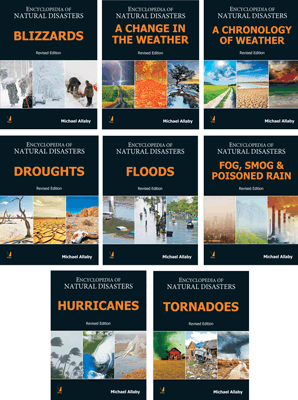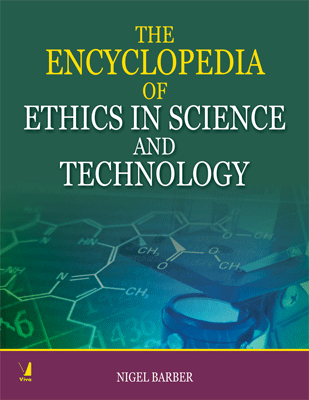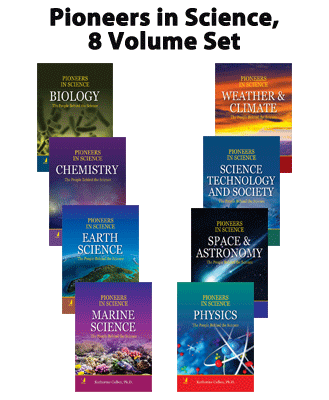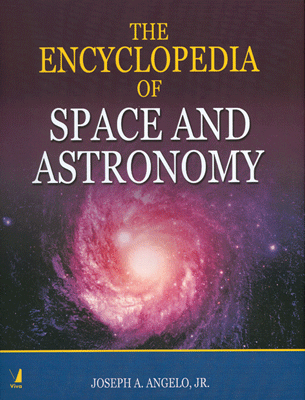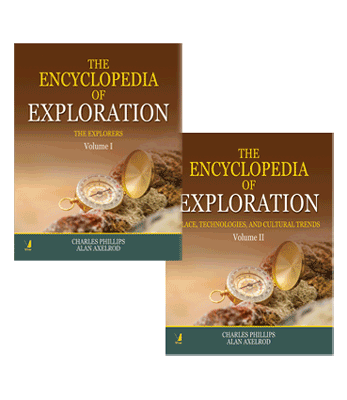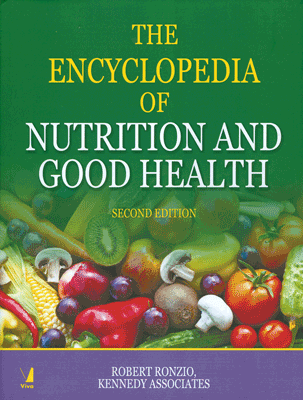Encyclopedia of Natural Disasters, 8 Vol Set
Encyclopedia of Natural Disasters, 8 Vol Set
₹11,695.50 ₹12,995.00 Save: ₹1,299.50 (10%)
Go to cartISBN: 9788130921587
Bind: Hardbound
Year: 2016
Pages: 1732
Size: 185 x 242 mm
Publisher: Facts On File Inc.
Published in India by: Viva Books
Exclusive Distributors: Viva Books
Sales Territory: India, Nepal, Pakistan, Bangladesh, Sri Lanka
Description:
Encyclopedia of Natural Disasters series is essential for students who require information on the fundamentals of extreme weather systems and their present and future environmental impact.
Targeted for students, teachers, and general readers, this updated and expanded Encyclopedia of Natural Disasters series is a collection of compelling illustrated books on the extreme weather conditions that threaten our environment and population. Michael Allaby, a noted weather and climate writer, offers an authoritative yet lively text that is enhanced by impressive line illustrations evoking the far-reaching effects of treacherous weather activity.
Volumes In The Set Include
• Blizzards
• A Change in the Weather
• A Chronology of Weather
• Droughts
• Floods
• Fog, Smog & Poisoned Rain
• Hurricanes
• Tornadoes
Blizzards
Blizzards, Revised Edition is a fascinating examination of this weather phenomenon and its impact on extensive areas of our planet. While blizzard is a word we may associate with the Far North or Antarctica, recent storms in China, Europe, and the United States show that blizzards can happen in lower latitudes and with serious consequences. Substantially updated since its original publication six years ago, this revised edition of Blizzards features information on
- air mass movements
- safety and protection
- snowstorms
- continental and maritime climates
- freezing rain and freezing fog
- the Great Ice Age
- historic blizzards
- wind chill and snow chill
Contents:
CONTINENTAL AND MARITIME CLIMATES • Seasons and the tilting Earth • Adiabatic cooling and warming • Movements of air and water • General circulation of the atmosphere • Continental and maritime climates • Calculating continentality and oceanicity • MOVEMENTS OF AIR MASSES IN WINTER • Cold air, high pressure • Air masses • Air masses and the weather they bring • When air masses move • When air masses meet • Distribution of pressure • Weather fronts • Jet stream • Why warm air can hold more moisture than cold air can • ICE CAPS, GLACIERS, AND ICEBERGS • Where glaciers form • The polar ice caps • How glaciers move • Why the Arctic is warmer than the Antarctic • Ice shelves and icebergs • North Atlantic Deep Water and the Great Conveyor • When the conveyor weakens or fails • READING PAST WEATHER FROM ICE SHEETS • Reading tree rings and ice cores • Lake Vostok. Europa. and Ganymede • Vostok GISP, and GRIP • Oxygen isotopes • Ice sheets and sea levels • Trapped greenhouse gases • Dust • Volcanic ash • Sediments, pollen, corals, and beetles • POLAR DESERTS, WHERE BLIZZARDS ARE COMMON • Blizzards faced by explorers • The difference between the Arctic and the Antarctic • Deserts, despite being covered with snow • Gales and extratropical hurricanes • LOUIS AGASSIZ AND THE GREAT ICE AGE • The puzzle of the erratic rocks • Agassiz and his vacations on the ice • Glaciers flow • Uniformitarians and catastrophists • Not one ice age, but many • Pleistocene glacials and intergiacials • Why do ice ages happen • • The Little Ice Age • SNOWBLITZ • Do ice sheets form from the top down or bottom up • • Albedo • At the edge of the snow • Positive feedback • Could it happen • • SNOWBALL EARTH • Ancient glacial deposits • Continental drift and plate tectonics • Could it happen • • The thaw leading to ?Greenhouse Earth • • The cap dolostones • Snowball or ?slushball? • • SNOW LINES • Dry air and moist air • Effect of the shape of a mountain • Mountain winds • Where snow is most likely • WHERE BLIZZARDS OCCUR • Cold climates are dry climates • Spring blizzards • The conditions that produce snowstorms • European blizzards • The Coriolis effect • GALES AND WHY THEY HAPPEN • How Torricelli weighed air and invented the barometer • Wind force and Admiral Beaufort • Why air pressure varies • Air does not move in straight lines • Christoph Buys Ballot and his law • HAIL, SLEET, SNOW • Mass, drag, and terminal velocity • Evaporation, condensation, and the formation of clouds • Humidity • Why drops of water are spherical • Why some fall faster than others • Rain, sleet, or snow • • Hail • FREEZING RAIN AND FREEZING FOG • Freezing nuclei • Supercooling • Rain that freezes on contact • Fog and frost • Freezing fog • WHAT HAPPENS WHEN WATER FREEZES AND ICE MELTS • Structure of the molecule • What happens when water is heated • The discovery of latent heat • Melting, freezing, and the change between gas and solid The universal solvent • WILSON BENTLEY, THE MAN WHO PHOTOGRAPHED SNOWFLAKES • The snowflake man • Studying snowflakes • Classification • SNOWFLAKES AND TYPES OF SNOW • How ice crystals grow • Why most snowflakes have six points, but each one is unique • Temperature affects the shape • Availability of atmospheric moisture • Inside the cloud • Once fallen, snow changes • AVALANCHES • The Force of moving snow • Kinetic energy • How an avalanche begins • Types of avalanches • Snow and wind • Safety • COLD AIR AND WARM WATER • Specific heat capacity • Radiation and blackbodies • Specific heat capacity and blackbodies • Conductivity, albedo, and transparency • Influence of oceans • SNOWSTORMS, DRIFTING, AND BLIZZARDS • Wind and the city • Urban climate • Snowdrifts • Drifts are dangerous • HEAVY SNOWSTORMS AND WHAT CAUSES THEM • Stability and lapse rates • Air pressure, highs, and lows • Conditions inside the cloud • Lightning • Charge separation • Precipitation • THE LAKE EFFECT • When air crosses water • Where the snow falls, and how much • Not only the Great Lakes • Lake effects in Europe and Asia • Advantages as well as disadvantages • COLD WAVES • The Great Cold Wave of February 1899 • Dangers of the cold • The polar front jet stream • Drawing warm air north and cold air south • Blocking • ICE STORMS • Research that led to rainmaking • Cloud seeding • Icing at ground level • Effects of an ice storm • WIND CHILL, FROSTBITE, HYPOTHERMIA, AND SNOW CHILL • Calculating wind chill • Dangers of exposure • Frostbite • Hypothermia • Snow chill • WHITEOUT • Scattering and reflecting light • What you should do • BLIZZARDS OF THE PAST • The 1888 American winter • Spring blizzards • Winter storms • The Northeast Blizzard of 1978 • The 19% storms • Blizzards in Europe • The 19% storms reach Europe • WILL CLIMATE CHANGE BRING FEWER BLIZZARDS • • Why worry • • The enhanced greenhouse effect • How the atmosphere absorbs heat • Tracing the emissions • The solar spectrum • Estimating the effects • Thermohaline circulation • FORECASTING BLIZZARDS • Problems of scale • Weather stations, balloons, and satellites • Forecasting • Warnings • SAFETY • Lay in supplies • IF you have to drive • When you hear the warning • Outdoors • IF the car is stuck • Appendixes • Beaufort Wind Scale • Avalanche classes • SI units and conversions • Prefixes used with SI units • Bibliography and lurther reading • Index.
A Change in the Weather
A Change in the Weather, Revised Edition is a fascinating examination of the history of climate change and its impact on extensive areas of our planet. It features information on:
- the atmosphere
- climates of the past and present
- global warming
- greenhouse gases
- ice ages
- radiation from the Sun and Earth
- sea levels
- wildlife
Contents:
HOW THE ATMOSPHERE PRODUCES OUR WEATHER • Composition and structure of the atmosphere Mars was not always a cold desert • Atmospheres of Earth, Venus, and Mars • How Earth acquired its three atmospheres • How oxygen accumulated • Layers of the atmosphere • Troposphere and tropopause • Stratosphere and stratopause • Mesosphere and mesopause • Thermosphere, exosphere, and ionosphere • GENERAL CIRCULATION OF THE ATMOSPHERE • Seasons and Tropics • Why Earth is not like the Moon • Trade winds and Hadley cells • George Hadley and Hadley cells • Polar and Ferrel cells • The Coriolis effect • TRANSPORT OF HEAT BY THE OCEANS • Ocean currents • El Nino • Thermohaline circulation and North Atlantic Deep Water The Great Conveyor • Ocean gyres and boundary currents • Why the Arctic is warmer than the Antarctic • EVAPORATION AND CONDENSATION AND HOW THEY PRODUCE OUR WEATHER • The water molecule and the hydrogen bond • Breaking the bond: evaporation • Specific heat capacity • Latent heat and adiabatic cooling and warming • Latent heat and dew point • Adiabatic cooling and warming • Potential temperature • Potential temperature • CLIMATES OF THE PAST • Revealing the past • Tree rings • Radiocarbon dating • Pollen and beetles • Seabed sediment • Ice cores • Vostok, GISP, and GRIP • Oxygen isotopes and ?heavy • water • Carbonate from the seabed • CLIMATE CHANGES THAT HAVE CHANGED HISTORY • Radiometric dating • Reading stalagmites • The Anasazi • The domestication oF animals and plants • Indus Valley civilization • Out oF the steppes oF Central Asia • The Mongol Empire • Khmer Empire • MILUTIN MILANKOVITCH AND HIS ASTRONOMICAL CYCLES • Eccentricity • Obliquity • The axial wobble • Hipparchus and the precession oF the equinoxes • The signil9cance oF precession • When the cycles coincide • The Milankovitch cycles • Adhemar and Croll • Milankovitch on Mars • ICE AGES OF THE PAST—AND FUTURE • • Louis Agassiz and the Great Ice Age • Louis Agassiz and the Great ice Age • Glacials, interglacials. and geologic time • i-low glaciers begin and move • Snowball Earth • Will there be more ice ages • • EDWARD WALTER MAUNDER AND THE UNRELIABLE SUN • The 11-year sunspot cycle • Sunspots • The Sporer Minimum, Dalton Minimum, and Maunder Minimum • Tree rings and isotopes • The inconstant Sun • Sunspots and cloud formation • The link persists • THE MEDIEVAL OPTIMUM • Cold weather during the Dark Ages • Norse colonies and explorations • Erik the Red and settlements in Greenland • Warm weather everywhere • Sea levels and higher rainfall • Start of the deterioration • THE LITTLE ICE AGE • Increasingly severe storms • Wet summers, poor harvests, and famines • Diseases favored by wet weather • Agriculture retreating from marginal land • Glaciers begin advancing • Cold winters in the lowlands • Frost fairs • Distribution of pressure • Slow recovery and the origin • of the ?traditional • Christmas scene • GREENHOUSE GASES AND THE GREENHOUSE EFFECT • Effective temperature • Radiation emission and absorption • jean-Baptiste Fourier, john Tyndall, and the greenhouse effect • Svante Arrhenius • The faint Sun paradox and the Gaia hypothesis • Svante Arrhenius • Snowball Earth and Greenhouse Earth • The Gala hypothesis • The enhanced greenhouse effect and global warming potentials • THE CARBON CYCLE • Respiration • Photosynthesis • The carbon reservoirs • The cycle—sources and sinks • Carbonate lysocline and carbonate • compensation depth • Perturbing the natural cycle • Carbon dioxide fertilization • and the missing carbon sink • HOW BRIGHT IS THE EARTH • • Albedo • Albedo and temperature • Positive feedback • Ice-albedo feedback and climate warming • Changing land use alters the albedo • CLOUDS AND PARTICLES • Some clouds are more reflective than others Reflection and absorption • Cloud condensation nuclei • John Aitken and cloud condensation nuclei • Atmospheric aerosols • Effect on radiation • Aerosols and clouds • RADIATION FROM THE SUN AND FROM THE EARTH • Electromagnetic radiation • Blackbody radiation • The spectrum and the rainbow • The complete electromagnetic spectrum • Solar wind, cosmic rays, and radioactive decay • The solar spectrum • THE RADIATION BALANCE • Latent heat and the owen ratio • Diurnal and seasonal changes • Incoming radiation and the ozone layer • Why the sky is blue • Outgoing radiation • MEASURING CLIMATE CHANGE • Siting the thermometer • Need to standardize instruments and the way they are used • The Central England temperature record • Measuring very small changes • Central England temperature record • SurFace stations • Weather balloons and satellites • Is the world growing warmer • • URBAN HEAT ISLANDS • City air is drier, but rainFall is higher • Humidity • Cities are less sunny • Cities are less windy, except along urban canyons • Heat islands and urban domes • Heat islands and global warming • IS THE SEA RISING • • The expansion and contraction of ice sheets • Isostasy and glacial rebound • Thermal expansion and storage • Records of sea level • Wll the sea rise in years to come • • Isle of the Dead • GLOBAL WARMING • The Intergovernmental Panel on Climate Change • The Third Assessment Report • Criticisms • Doubts about economic growth • MODELING THE ATMOSPHERE • Constructing models • The gas laws • The development of climate models • Lapse rates and stability • Models have limitations • Other approaches to modeling • IS CLIMATE CHANGE ALL BAD • • Evaporation and effective precipitation • Effects on agriculture • Effects on wildlife • Most warming in high latitudes • Exotic diseases • Sea levels and storms • CAN WE PREVENT CLIMATE CHANGE OR MUST WE ACCEPT AND ADAPT TO IT • • The precautionary principle • Reducing emissions • The UN Framework Convention on Climate Change and the Kyoto Protocol • Is Kyoto achievable • • Appendixes
A Chronology of Weather
A Chronology of Weather, Revised Edition begins with a fascinating history of the world's climate. Two chronological accounts follow: the first spans 5,000 years of major weather events listed by the year in which they occurred; the second documents important advances in the understanding of weather, relevant inventions and their inventors, and improvements in forecasting. These advances are also listed chronologically and, where appropriate, include brief biographical details about the person or persons responsible for them. Substantially updated since its original publication six years ago, this revised edition of A Chronology of Weather includes information on:
- cloud classification
- the Coriolis effect
- the Greenhouse Effect
- the Earth's orbit and the Sun
- the first weather forecasts
- north American air masses
- precipitation
- weather satellites
Contents:
A Chronology of Weather • History of our Weather • As the ice retreated • Moving continents • When the Sahara was green • Vikings in Greenland • The Little Ice Age • The greenhouse effect • History of the Science of Weather • Weather lore • Invention of Instruments • The telegraph and the first weather forecasts • Weather balloons • Weather satellites • A Chronicle of Destruction: 5000 years of Dangerous Weather • A Chronology of Discovery • Weather Data • Index
Droughts
Praise for the original edition of Droughts:
...readable explanations of scientific concepts and clearly defined terms...a handy resource and a solid curricular supplement.
—Booklist
Droughts, Revised Edition examines extreme aridity and its impact on extensive areas of Earth. Substantially updated since its original publication five years ago, this edition of Droughts features information on
- climate and the environment
- coping with drought
- deserts and their geography
- global climate research
- life in deserts
- soil erosion
- water above and below the soil
- water conservation
Contents:
When the Rains Fail • Where the deserts are • Specific heat capacity and blackbodies • Subtropical deserts • Temperature inversions • Adiabatic cooling and warming • Humidity • West Coast deserts • Land and sea breezes • Polar deserts • Air movements and the transport of heat • Potential temperature • Precipitation, evaporation, sublimation, deposition, and ablation • George Hadley and Hadley cells • General circulation of the atmosphere • Latent heat and dew point • Evaporation, condensation and the formation of clouds Lapse rates and stability • Ocean currents and sea-surface temperature • The coriolis effect • Climate cycles and oscillations • Intertropical convergence and the equatorial trough • El Nino and La Nina • Jet streams and storm tracks • Blocking highs • Weather fronts • Vorticity and angular momentum • Water and Life • Desert life • The ?ship of the desert • • Life near the poles • Hibernation • Peoples of the desert • Why plants need water • C3. C4. and CAM plants • Osmosis • Water in the Ground • Water below ground • Wells and springs • What Droughts Can Do • How droughts are classified • Droughts of the past • Drought and soil erosion • Soil erodibility • The Dust Bowl • The Sahel • Monsoons • Coping with Drought • Dry-weather farming • Irrigation • Water for people • Water recycling and purification • Desalination • Water storage • Saving water • Will climate change bring more droughts • • The solar spectrum • Appendixes
Floods
Floods, Revised Edition is a fascinating examination of this weather phenomenon and its impact on extensive areas of our planet. For example, floods in eastern and central Texas in July 2002 were so severe that many countries were declared disaster areas and eight people lost their lives.
Substantially updated since its original publication six years ago, this revised edition of Floods features information on
- coastal erosion and other flood-related damage
- the cost of floods
- flood and agriculture
- prevention and warnings
- rainstorms
- thunder and lightning
- tide activities
- where floods are likely to happen
Contents:
Preface: What is a flood • • Introduction • How Water Moves • Where Floods Happen • El Nino • Evaporation, precipitation, and transpiration • Partial pressure and vapor pressure • Humidity • How the land drains • Rivers • Why it rains more on mountainsides • Kinetic energy • Floodplains and meanders • The Bernoulli effect • Flash floods • Rainstorms • Storms and cloudbursts • Lapse rates and stability • Latent heat and dewpoint • Thunder and lightning • Charge separation • When the sea rises • Tsunamis • Tsunami Warning System • Tiders • Laws of motion • The Coriolis effect • Tidal Surges • Air pressure • hights and lows • Coping with floods • Monsoons • Intertropical convergence and the equatorial trough • Aquifers, springs, and wells • Vegetation and natural drainage • Floods and Agriculture • The Nile floods and the Aswan Dams • Wet rice farming • The Cost of Floods • Coastal erosion • Glacioisostasy • Isle of the Dead • Saltwater infiltration • Osmosis • Flood damage • Floods and soil erosion • Soil erosion • Floods of the past • Prevention, Warning, and Survival • Land drainage • Wetlands • Levees • Dams • Canalization • Flood prediction • Safety • Appendix
Fog, Smog & Poisoned Rain
Fog, Smog & Poisoned Rain, Revised Edition is a fascinating examination of air pollution and its impact on extensive areas of our planet. It features information on
- acid rain
- factory and power plant emissions
- fossil fuels
- ?natural • pollution
- ozone and ultraviolet radiation
- pollution and health
- safer source of energy
- weather fronts
Contents:
Water in the Air • Air masses and fronts in summer and winter • General circulation of the atmosphere • Temperature inversions • Evaporation and condensation • Types of fog • Adiabatic cooling and warming • Clouds types and cloud classification • Fires, Cars, Smogs, and Fogs • What happen when fuel burns • • What are fossil fuels • • What is a flame • • Pea soup: The original smog • Methane hydrates • Vehicle exhausts • Fogs in literature • Steam cars • Photochemical smog • The photolytic cycle • Low-level ozone • Land and sea breezes • Fogs and smogs of the past • Factory and power plant chimneys and the gases the emit • Chimney stacks and plumes • Buoyancy • Acid in the Air • Acid rain and Manchester air • Acid rain, snow, mist, and dry deposition • Acidification of soils, forests, and lakes • Ozone and Ultraviolet Radiation • Spray cans and the ozone layer • Structure of the atmosphere • CFCs and Freons • Natural Polluters • Volcanoes • Volcanic eruptions and climate • Killer trees • • The Gaia hypothesis • Pollution from wildfires • El Nino • Asian fires of 1997 • 1998 • The Ash Wednesday fires • Curing the Air • Pollution and health • Trapping pollutants • Static electricity • New cars for old • Fuel cells • Airship • Heat without fire • Sun and wind • Laws and treaties • Will the world of tomorrow have cleaner or dirtier air • • Appendixes
Hurricanes
Hurricanes, Revised Edition is a fascinating examination of extreme weather phenomenon and its impact on extensive areas of our planet. Substantially updated, this revised edition of Hurricanes features information on
- the ?anatomy • of a hurricane
- circulation of the atmosphere
- cloud formation and classification
- the global climate
- historic hurricanes
- safety and protection
- typhoons and cyclones
- the worldwide impact of hurricanes
Contents:
Why Hurricanes are Tropical • What happened when Mitch struck • • Convection • Lapse rates and stability • Where hurricanes happen • Intertropical convergence and the equatorial trough • Jet stream • Hurricane and storm tracks • Weather fronts • Global wind systems • Air and Sea • Ocean currents and sea-surface temperature • General circulation of the atmosphere • Trade winds and doldrums • George Hadley and Hadley cells • Potential temperature • Warming, convection, and low pressure • Adiabatic cooling and warming • Air pressure, high and lows • Storm clouds • How clouds are classified • Latent heat and dewpoint • Evaporation, condensation and the formation of clouds • Inside the Storm • How a hurricane begins • Christoph Buys Ballot and his law • Vortices • The Coriolls effect • Conservation of angular momentum • What happens inside a hurricane • Why the wind blows • Wind force and Admiral Beaufort • Hurricanes, Typhoons, and Cyclones • Hurricanes in the United States and Caribbean • Hurricanes that reach Europe • Air masses and the weather they bring • Depressions and the jet stream • Asian typhoons and cyclones • Monsoon • Arctic and Antarctic Hurricanes • What a Hurricane can Do • Hurricane damage • Kinetic energy and wind force • Saffir/Simpson Hurricane Scale • Daniel Bernoulli and how hurricanes can lift roofs • Storm surges • Historic Hurricanes • Living with Fierce Storms • How hurricanes are named and tracked • How hurricane damage is predicted • Will global climate change bring more hurricanes • • El Nino • The solar spectrum • Protection and safety • Appendixes
Tornadoes
Tornadoes, Revised Edition is a fascinating examination of this weather phenomenon and its impact on extensive areas of our planet. Although tornadoes occur worldwide, the United States has by far the most tornadoes of any other country, with about 1,000 occurring in an average year. In fact, the geography of the Great Plains of the central United States uniquely manifests all of the essential requirements for tornado formation.
Substantially updated since its original publication seven years ago, Tornadoes, Revised Edition features information on
- the conditions for a tornado
- the ?inside • of a tornado
- jet streams
- notable tornadoes
- safety conditions during a tornado
- the structure of a tornado
- tracking and forecasting
Contents:
When Warm and Cold Air Collide • How air masses form • Why warm air can hold more moisture than cold air can • Rising air becomes cooler, subsiding air warmer • Air masses and the weather they bring • Fronts • Adiabatic cooling and warming • Storms over the Great Plains • Weather fronts • How Wind changes with Height • Pressure gradient • Air pressure, highs and lows • Balance of forces acting on moving air • Christoph Buys Ballot and his law • The Ekman spiral • Wind and air navigation • The North Atlantic Oscillation and The Pacific Decadal Oscillation • El Nino • North Atlantic Oscillation • The NAO index • The Arctic Oscillation • Pacific/North American pattern • Pacific Decadal oscillation (PDO) • Jet Streams • A ribbon of wind • Rossby waves • The index cycle • Thermal winds • The Polar Front • George Hadley and Hadley cells • Potential temperature • Thunderstorms • Stability and instability • Evaporation, condensation, and the formation of clouds • Condensation and latent heat • Latent heat and dew point • Upcurrents and downcurrents • Inside a cumulonimbus storm cloud • Snow and hail • Birth of a thunderstorm • Charge separation • Lightning • Squall Lines • The final journey • Airships • The storm cloud • Conditions for a squall line • Gustnadoes • The squall line appears • The squall line perpetuates itself • Nonfrontal squall lines • Tornado Outbreaks • The 1999 outbreak • Enigma and Tri-State • Palm Sunday and Easter Sunday • Mother's Day • Winter tornadoes • How a Tornado Begins • Mammatus • Vertical currents • Wind Shear and the mesocyclone • Mesocyclones • Tornadoes without tornadic storms • Nonmesocyclone tornadoes • Supercells • Separating the vertical currents • Giant cells and firestorms • Lapse rates and stability • Danger to aircraft • Rising air and the structure of the atmosphere • Downcurrents and precipitation • Rotation • Vortices and Angular Momentum • Coriolis effect and the ?bath plug vortex • • The Coriolis effect • Planetary vorticity, relative vorticity, and absolute vorticity • Conservation of angular momentum • The tornado vortex • The Structure of a Tornado • Why the funnel extends downward, and how it becomes visible • Dust and debris • Suction vortices • What Happens inside a Tornado • Will Keller's story • Illuminated tornadoes • How a Tornado Travels • Multicell storms • Supercell storms • Tracking storms • Tornadoes rarely travel very far • How a Tornado Dies • A huge concentration of energy • The energy dissipates • The laws of thermodynamics • Dust Devils and Whirlwinds • A whirlwind is not a tornado • Convection and specific heat capacity • Specific heat capacity • Whirlwinds rise when the air is calm • Why they rise without warning and die suddenly • Waterspouts and Water Devils • Is Nessie a water devil • • Waterspouts • How waterspouts form • Nonsupercell tornadoes and gustnadoes • Raining Fish • Fishes from on high • Flying frogs • Turtles, nuts, and cans • When and Where Tornadoes Happen • Tropical cyclones and tornadoes • Tornadolike winds • Conditions for a tornado • Whey there are more tornadoes in summer • Tornado Alley • Where tornadoes are most frequent • Tornado Alley • Collision of air masses over the Great Plains • Tornadoes in Europe • Tornadoes can happen anywhere • Widecombe-in-the-Moor and its encounter with a fireball • What are fireballs • • Suction vortices and crop circles • Tornadoes of the Past • European tornadoes • Outbreaks • Most tornadoes are short-lived • Bangladesh and India • Tornadoes in China • Measuring the Severity of Tornadoes • Calculating wind speed from the pressure gradient • Inferring wind speed from its effects • Doppler radar • Discovery of the Doppler effect • Studying Tornadoes • Radiosondes and rawinsondes • Preparing to record a tornado • Resolution • Studying tornadoes from the air • Computer models • The need for ?ground truth • • Tracking and Forecasting Tornadoes • Mapping weather system • Observation of the upper atmosphere • Orbiting satellites • Weather satellites • Doppler radar • Assembling and interpreting the data • Warnings • Damage from Tornadoes • Property damage • Centripetal force • Force of the wind • Kinetic energy • Pressure in the vortex • Winds ahead of and behind the tornado • The Bernoulli effect • Will Climate change Bring more Tornadoes • • Identifiying the changes • Present climate change • Is warmer weather also stormier • • The solar spectrum • Jet stream • Are tornadoes becoming more frequent • • Safety During a Tornado • Make sure family members keep in touch and know what to do • Laying in supplies • When you hear a tornado watch • When you hear a tornado warning • Mobile homes, trailers, cars, and public spaces • Avoid complacency • Appendixes
About the Author:
Michael Allaby is the author, coauthor, or editor of more than 40 books, mainly on science, natural history, and environmental topics.
